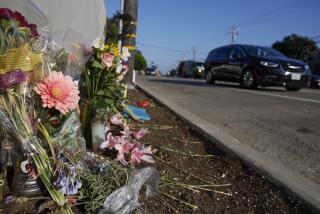State Awards $1.3 Million to Paralyzed Motorcyclist
- Share via
The state has agreed to pay a $1.3-million out-of-court settlement to a Redondo Beach motorcyclist who became a quadriplegic after crashing on a downhill hairpin curve on California 76 east of Julian. He had claimed the road had no warning sign.
The agreement, which was reached last week in Superior Court, represents one of the largest pretrial settlements that the state has recently paid, said Kevin Calcagnie, one of two attorneys who represented the motorcyclist, Lawrence Barnes, 30.
The settlement stems from a June, 1983, accident in which Barnes crashed on a 180-degree curve. Barnes, who was wearing a helmet, careened off a guardrail and suffered a severe spinal cord injury. The weather was clear and he was traveling about 45 m.p.h., which was within the speed limit.
His attorneys said no sign was posted to warn motorists to slow or signal to them that the hairpin turn was approaching. It is the first among a series of curves.
The case went to trial before the settlement was reached. During the trial, Barnes’ other attorney, Mark Robinson Jr., argued that state records show 19 single-vehicle accidents occurring on the curve from 1975 to 1985.
The state attempted to show that a warning sign was there on the day Barnes crashed, but later testimony from a state highway employee, who conducted a sign inventory survey, conflicted with that contention.
The employee’s testimony suggested that probably no sign was erected until 1986, Robinson said.
“The overwhelming weight of evidence demonstrated that no sign existed before the curve,” Robinson said. “And, when the sign was re-installed in 1986, that was the first year since 1977 in which there have been no accidents at that location.”
State highway standards specify that a warning sign must be posted at least 250 feet before a curve, he said.
More to Read
Sign up for Essential California
The most important California stories and recommendations in your inbox every morning.
You may occasionally receive promotional content from the Los Angeles Times.













